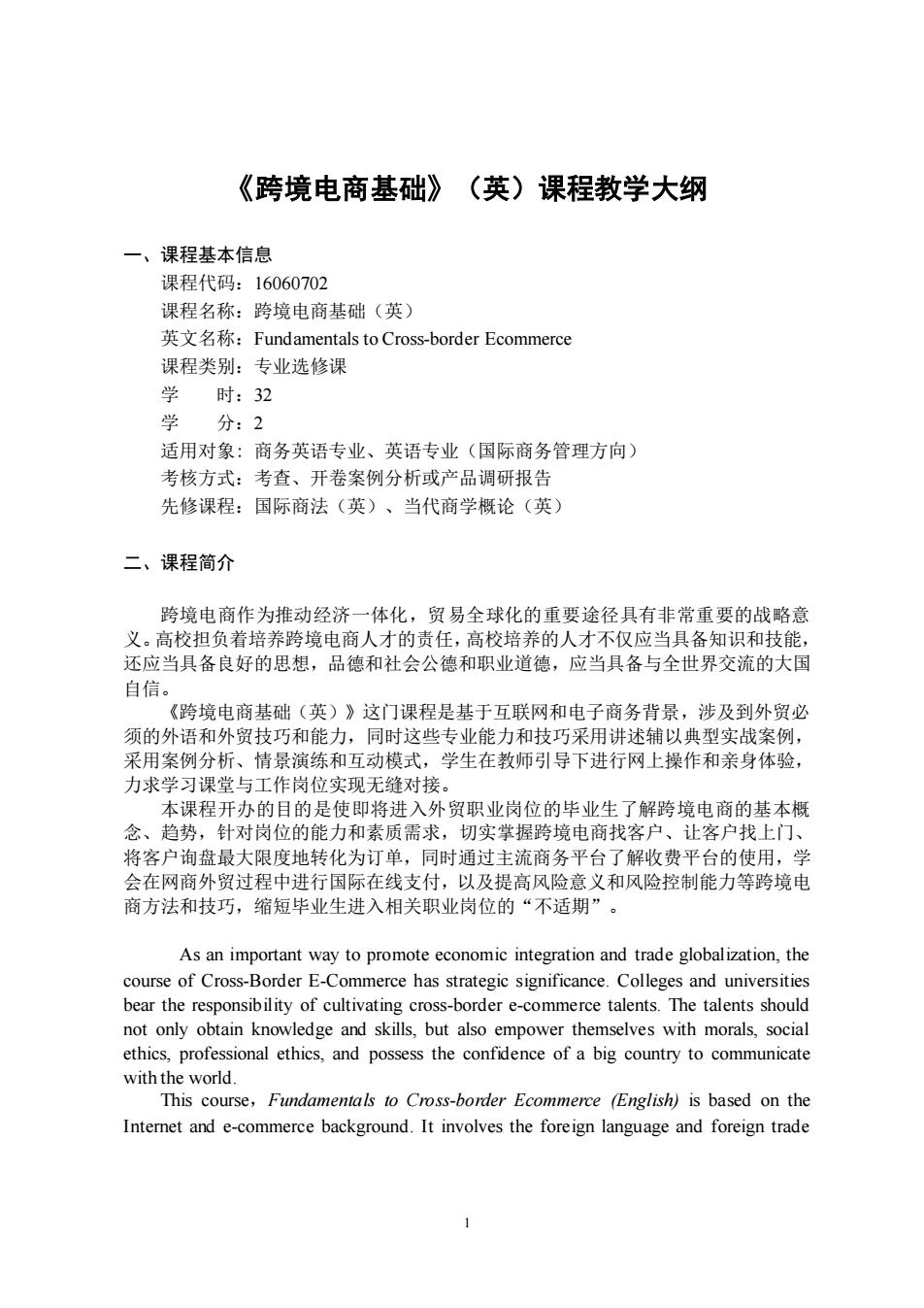
《跨境电商基础》(英)课程教学大纲 一、课程基本信息 课程代码:16060702 课程名称:跨境电商基础(英) 英文名称:Fundamentals to Cross-.border Ecommerce 课程类别:专业选修课 时:32 学 分分:2 适用对象:商务英语专业、英语专业(国际商务管理方向) 考核方式:考查、开卷案例分析或产品调研报告 先修课程:国际商法(英)、当代商学概论(英) 二、课程简介 跨培由商作为推动经济一体化,留易全球化的重要途径且有非常重要的战路高 义。高校担负者 培》 跨境电 商人才白 责任, 高校培养的人才 不仅应当具备知识和技 还应当具备良好的思想,品德和社会公德和职业道德,应当具备与全世界交流的大国 自信 《跨境电商基础(英)》这门课程是基于互联网和电子商务背景,涉及到外贸必 须的外语和外贸技巧和能力,同时这些专业能力和技巧采用讲述辅以典型实战案例, 采用案例分析、情景演练和互动模式,学生在教师引导下进行网上操作和亲身体验 力求学习课堂与工作岗位实现无缝对接 本课程开办的目的是使即将进入外贸职业岗位的毕业生了解跨境电商的基本概 念、趋势,针对岗位的能力和素质需求,切实掌握跨境电商找客户、让客户找上门、 将客户询盘最大限度地转化为订单,同时通过主流商务平台了解收费平台的使用,学 会在网商外贸过程中进行国际在线支付,以及提高风险意义和风险控制能力等跨境电 商方法和技巧,缩短毕业生进入相关职业岗位的“不适期 As an important way to promote economic integration and trade globalization,the bear the res ponsibility of cutivati cross-border e-commerce talents.The talent s should not only obtain knowledge and skills,but also empower themselves with morals,social ethics.professional ethics,and possess the confidence of a big country to communicate with the world. This course,Fundamentals to Cross-border Ecommerce (English)is based on the Intemet and e-commerce background.It involves the foreign language and foreign trade 1
1 《跨境电商基础》(英)课程教学大纲 一、课程基本信息 课程代码:16060702 课程名称:跨境电商基础(英) 英文名称:Fundamentals to Cross-border Ecommerce 课程类别:专业选修课 学 时:32 学 分:2 适用对象: 商务英语专业、英语专业(国际商务管理方向) 考核方式:考查、开卷案例分析或产品调研报告 先修课程:国际商法(英)、当代商学概论(英) 二、课程简介 跨境电商作为推动经济一体化,贸易全球化的重要途径具有非常重要的战略意 义。高校担负着培养跨境电商人才的责任,高校培养的人才不仅应当具备知识和技能, 还应当具备良好的思想,品德和社会公德和职业道德,应当具备与全世界交流的大国 自信。 《跨境电商基础(英)》这门课程是基于互联网和电子商务背景,涉及到外贸必 须的外语和外贸技巧和能力,同时这些专业能力和技巧采用讲述辅以典型实战案例, 采用案例分析、情景演练和互动模式,学生在教师引导下进行网上操作和亲身体验, 力求学习课堂与工作岗位实现无缝对接。 本课程开办的目的是使即将进入外贸职业岗位的毕业生了解跨境电商的基本概 念、趋势,针对岗位的能力和素质需求,切实掌握跨境电商找客户、让客户找上门、 将客户询盘最大限度地转化为订单,同时通过主流商务平台了解收费平台的使用,学 会在网商外贸过程中进行国际在线支付,以及提高风险意义和风险控制能力等跨境电 商方法和技巧,缩短毕业生进入相关职业岗位的“不适期”。 As an important way to promote economic integration and trade globalization, the course of Cross-Border E-Commerce has strategic significance. Colleges and universities bear the responsibility of cultivating cross-border e-commerce talents. The talents should not only obtain knowledge and skills, but also empower themselves with morals, social ethics, professional ethics, and possess the confidence of a big country to communicate with the world. This course,Fundamentals to Cross-border Ecommerce (English) is based on the Internet and e-commerce background. It involves the foreign language and foreign trade
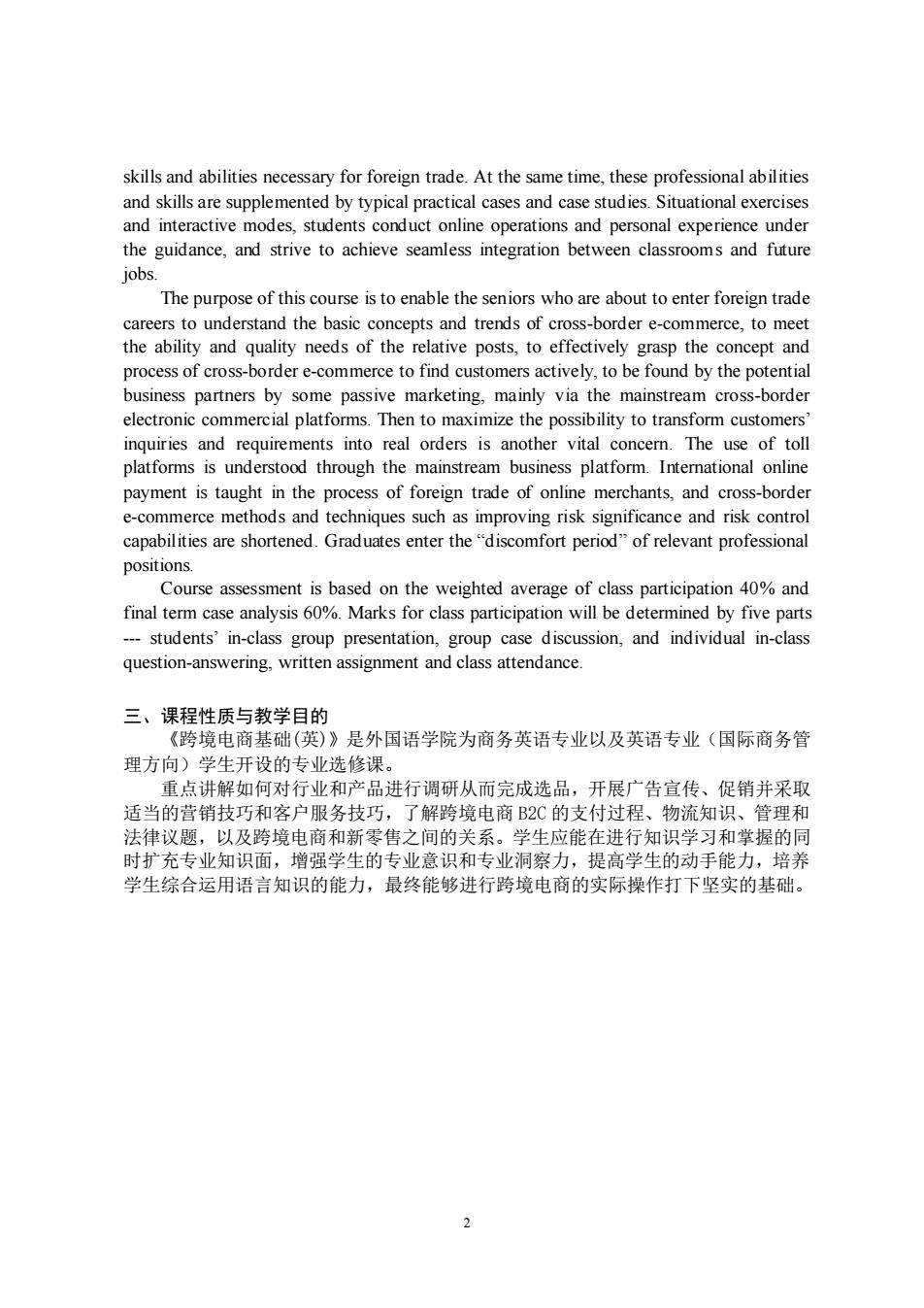
skills and abilities necessary for foreign trade.At the same time,these professional abilities and skills are supplemented by typical practical cases and case studies.Situational exercises and interactive modes.students the guidance,oachieve seamles integraion between fuure jobs The purpose of this course is to enable the seniors who are about to enter foreign trade careers to understand the basic concepts and trends of cross-border e-commerce.to meet the ability and quality needs of the relative posts,to effectively grasp the concept and process of cross-bord er e-comm erce to find custor vely,to be und by the potential business partners by some passive marketing,mainly via the mainstream cross-borde electronic commercial platforms.Then to maximize the possibility to transform customers' inquiries and requirements into real orders is another vital concern.The use of toll platforms is understood through the mainstream business platform.International online payment is taught in the process of foreign trade of online merchants,and cross-border e-comm erce methods and techniques such as improving risk significance and risk contro capabilities are shortened.Graduates enter the "discomfort perod"of relevant professional positions. Course assessment is based on the weighted average of class participation 40%and final term case analysis 60%.Marks for class participation will be determined by five parts studentsin-ass,and individual in-cs question-answering,written assignment and class attendance 三、课程性质与教学目的 《跨境电商基础(英)》是外国语学院为商务英语专业以及英语专业(国际商务管 理方向)学生开设的专业选修课。 重点讲解如何对行业和产品进行调研从而完成选品,开展广告宣传、促销并采取 适当的营销技巧和客户服务技巧,了解跨境电商B2C的支付过程、物流知识、管理和 法律议题,以及跨境电商和新零售之间的关系。学生应能在进行知识学习和掌握的同 时扩充专业知识面 增强学4 的专业意识和专业洞察力 提高学生的动手能力,培养 学生综合运用语言知识的能力,最终能够进行跨境电商的实际操作打下坚实的基础
2 skills and abilities necessary for foreign trade. At the same time, these professional abilities and skills are supplemented by typical practical cases and case studies. Situational exercises and interactive modes, students conduct online operations and personal experience under the guidance, and strive to achieve seamless integration between classrooms and future jobs. The purpose of this course is to enable the seniors who are about to enter foreign trade careers to understand the basic concepts and trends of cross-border e-commerce, to meet the ability and quality needs of the relative posts, to effectively grasp the concept and process of cross-border e-commerce to find customers actively, to be found by the potential business partners by some passive marketing, mainly via the mainstream cross-border electronic commercial platforms. Then to maximize the possibility to transform customers’ inquiries and requirements into real orders is another vital concern. The use of toll platforms is understood through the mainstream business platform. International online payment is taught in the process of foreign trade of online merchants, and cross-border e-commerce methods and techniques such as improving risk significance and risk control capabilities are shortened. Graduates enter the “discomfort period” of relevant professional positions. Course assessment is based on the weighted average of class participation 40% and final term case analysis 60%. Marks for class participation will be determined by five parts --- students’ in-class group presentation, group case discussion, and individual in-class question-answering, written assignment and class attendance. 三、课程性质与教学目的 《跨境电商基础(英)》是外国语学院为商务英语专业以及英语专业(国际商务管 理方向)学生开设的专业选修课。 重点讲解如何对行业和产品进行调研从而完成选品,开展广告宣传、促销并采取 适当的营销技巧和客户服务技巧,了解跨境电商 B2C 的支付过程、物流知识、管理和 法律议题,以及跨境电商和新零售之间的关系。学生应能在进行知识学习和掌握的同 时扩充专业知识面,增强学生的专业意识和专业洞察力,提高学生的动手能力,培养 学生综合运用语言知识的能力,最终能够进行跨境电商的实际操作打下坚实的基础

四、教学内容及要求 Orientation: Introduction to Cross-border Ecommerce I.Teaching Objeetives: 1.To understand the course design,teaching plan and course assessment. 2.To define“what cross-border ecommerce is” To define"B2B B2C" 4 To understand the history and development of cross-border ecommerce 5.To describe the sources of cross-border e-commerce 6.To describe and compare the principal cross-border e-commercial platforms II.Contents: Section A:Course Description and Concept of Cross-border Ecommerce 1.A case example 2.Course Description 3.Teaching Plan 45 Course Assessment What is cross-border ecommerce? Section B:An Overall View of Cross-border Ecommerce 1.What is cross-border ecommerce? 2.History of cros ecomn erce 3 Sources of cross-border ecommerce 4.Comparison of mainstream cross-border B2B and B2C platforms III.After-class exercises: A Survey into the basic requirements and qualifications listed on the recruitment posts Preparation for group presentation on the given task IV.Teaching methods and aids: Lectures with PPT in a multimedia classroom,group discussions.Q&A.students group presentations,case study 3
3 四、教学内容及要求 Orientation: Introduction to Cross-border Ecommerce Ⅰ. Teaching Objectives: 1.To understand the course design, teaching plan and course assessment. 2.To define “what cross-border ecommerce is” 3.To define “B2B & B2C” 4.To understand the history and development of cross-border ecommerce 5.To describe the sources of cross-border e-commerce 6.To describe and compare the principal cross-border e-commercial platforms Ⅱ. Contents: Section A: Course Description and Concept of Cross-border Ecommerce 1.A case example 2.Course Description 3.Teaching Plan 4.Course Assessment 5.What is cross-border ecommerce? Section B: An Overall View of Cross-border Ecommerce 1.What is cross-border ecommerce? 2.History of cross-border ecommerce 3.Sources of cross-border ecommerce 4.Comparison of mainstream cross-border B2B and B2C platforms Ⅲ.After-class exercises: A Survey into the basic requirements and qualifications listed on the recruitment posts Preparation for group presentation on the given task . Ⅳ. Teaching methods and aids: Lectures with PPT in a multimedia classroom, group discussions, Q & A, students’ group presentations, case study
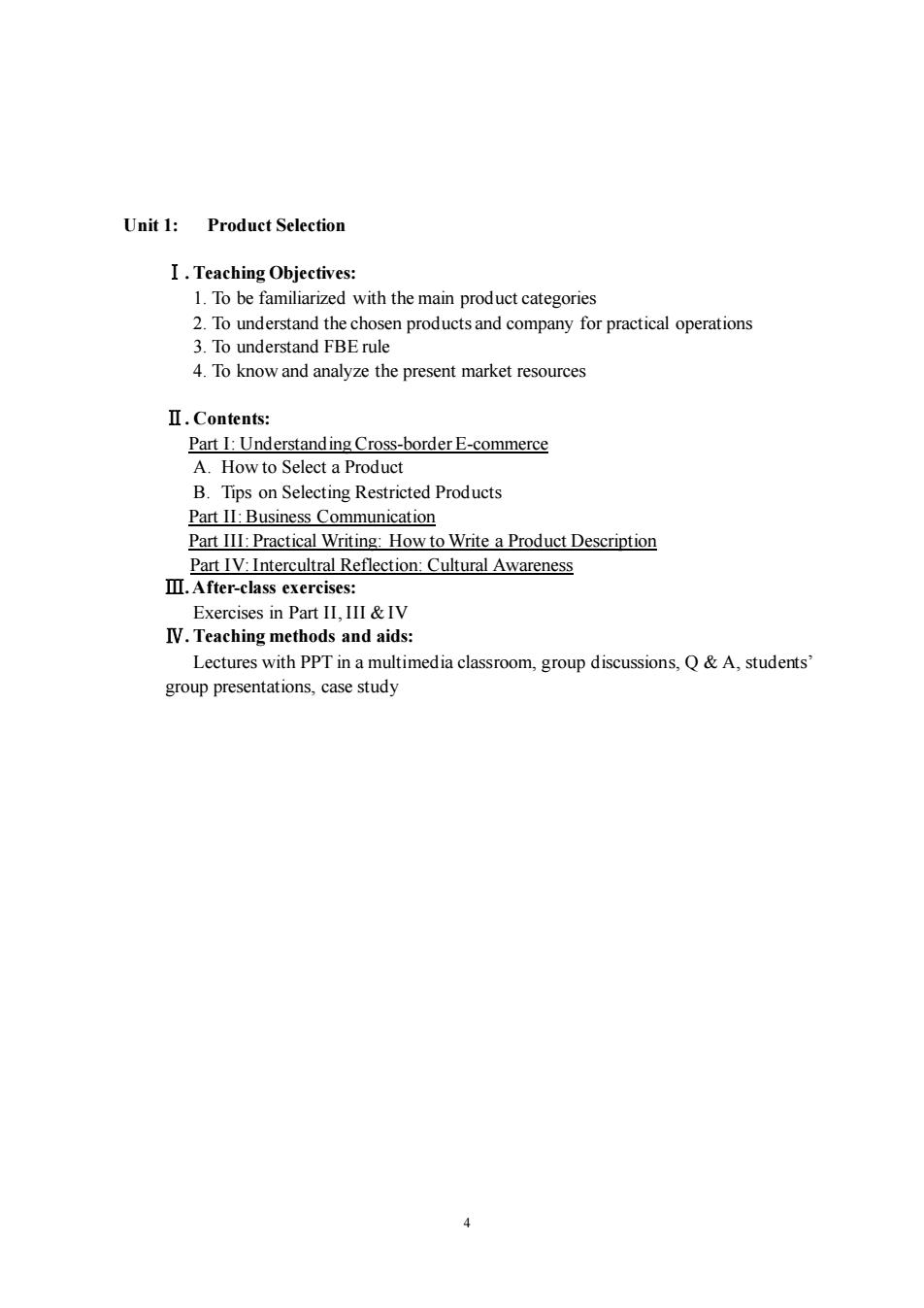
Unit 1: Product Selection I.Teaching Objectives: 1.To be familiarized with the main product categories 2.To understand the chosen products and company for practical operations 3.To understand fBerule 4.To know and analyze the present market resources Ⅱ.Contents: Part I:Understanding Cross-border E-commerce A.How to Select a Product B.Tips on Selecting Restricted Products Part I Business Co mmunication Part III:Practical Writing:How to Write a Product Description Part IV:Intercultral Reflection:Cultural Awareness III.After-class exercises: Exercises in Part Il ill &Iv IV.Teaching methods and aids Lectures with PPT in a multimedia classroom,group discussions,Q&A,students group presentations,case study
4 Unit 1: Product Selection Ⅰ. Teaching Objectives: 1. To be familiarized with the main product categories 2. To understand the chosen products and company for practical operations 3. To understand FBE rule 4. To know and analyze the present market resources Ⅱ. Contents: Part I: Understanding Cross-border E-commerce A. How to Select a Product B. Tips on Selecting Restricted Products Part II:Business Communication Part III: Practical Writing: How to Write a Product Description Part IV:Intercultral Reflection: Cultural Awareness Ⅲ.After-class exercises: Exercises in Part II, III & IV Ⅳ. Teaching methods and aids: Lectures with PPT in a multimedia classroom, group discussions, Q & A, students’ group presentations, case study
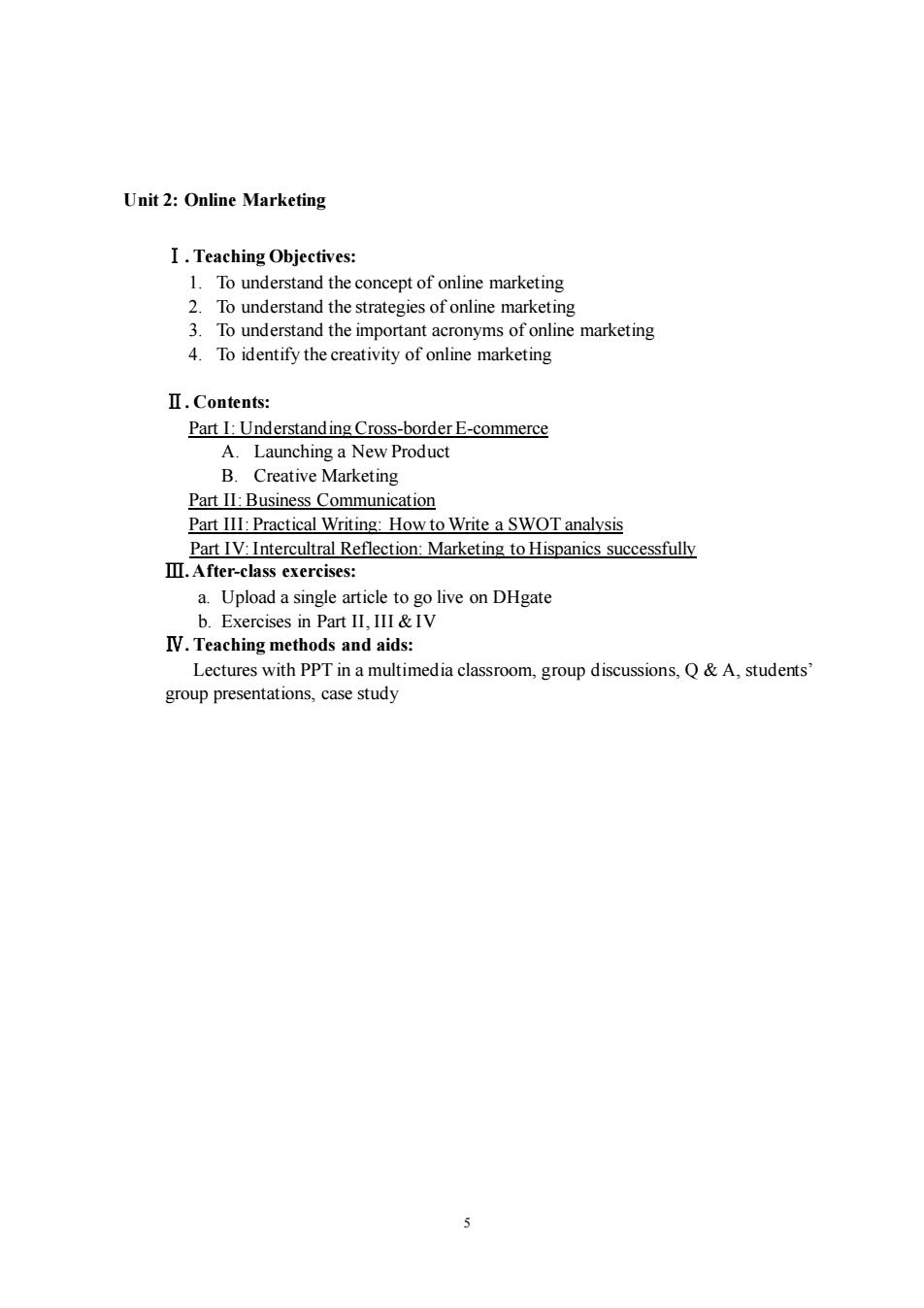
Unit 2:Online Marketing I.Teaching Objectives: 1.To understand the concept of online marketing To understand the strategies of online market To understand the important acronyms of online marketing 4.To identify the creativity of online marketing II.Contents: Part I:Understanding Cross-border E-commerce Launching a New Produc B. Creative Marketing Part Il:Business Communication Part III:Practical Writing:How to Write a SWOT analysis Part IV:Intercultral Reflection:Marketing to Hispanics successfully se a.Upload a single article to go live on DHgate b.Exercises in Part II,III &IV IV.Teaching methods and aids: Lectures with PPT in a multimedia classroom,group discussions.Q&A.students group presentations,case study
5 Unit 2: Online Marketing Ⅰ. Teaching Objectives: 1. To understand the concept of online marketing 2. To understand the strategies of online marketing 3. To understand the important acronyms of online marketing 4. To identify the creativity of online marketing Ⅱ. Contents: Part I: Understanding Cross-border E-commerce A. Launching a New Product B. Creative Marketing Part II:Business Communication Part III: Practical Writing: How to Write a SWOT analysis Part IV:Intercultral Reflection: Marketing to Hispanics successfully Ⅲ.After-class exercises: a. Upload a single article to go live on DHgate b. Exercises in Part II, III & IV Ⅳ. Teaching methods and aids: Lectures with PPT in a multimedia classroom, group discussions, Q & A, students’ group presentations, case study
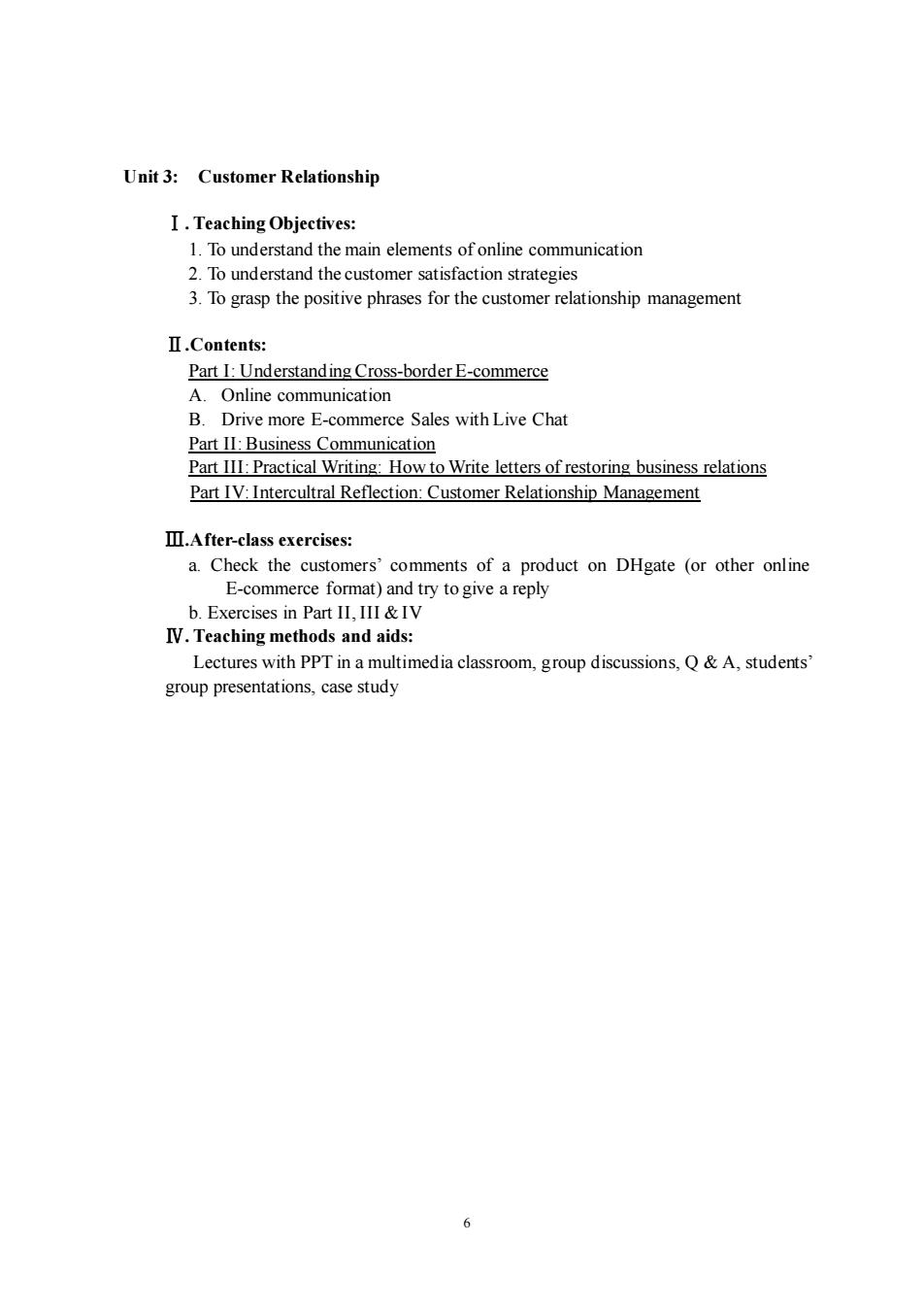
Unit 3:Customer Relationship I.Teaching Objectives: 1.To understand the main elements of online communication 2.To understand the customer satisfaction strategies 3.To grasp the positive phrases for the customer relationship management Ⅱ.Contents:: Online communication B.Drive more E-commerce Sales with Live Chat Part II:Business Communication Part III:Practical Writing:How to Write letters of restoring business relations Part IV:Intercultral Reflection:Customer Relationship Management I.After-class exercises: a.Check the customers'comments of a product on DHgate (or other online E-commerce format)and try to give a reply b Exercises in Part Il ill&Iv IV.Teaching methods and aids: Lectures with PPT in a multimedia classroom,group discussions,Q&A,students group presentations,case study
6 Unit 3: Customer Relationship Ⅰ. Teaching Objectives: 1. To understand the main elements of online communication 2. To understand the customer satisfaction strategies 3. To grasp the positive phrases for the customer relationship management Ⅱ.Contents: Part I: Understanding Cross-border E-commerce A. Online communication B. Drive more E-commerce Sales with Live Chat Part II:Business Communication Part III: Practical Writing: How to Write letters of restoring business relations Part IV:Intercultral Reflection: Customer Relationship Management Ⅲ.After-class exercises: a. Check the customers’ comments of a product on DHgate (or other online E-commerce format) and try to give a reply b. Exercises in Part II, III & IV Ⅳ. Teaching methods and aids: Lectures with PPT in a multimedia classroom, group discussions, Q & A, students’ group presentations, case study

Unit 4:Online Payment I.Teaching Objectives: 1.To understand the mainstream online payment channels 2.To understand the security issues ofonline payments To master the terms of online payment Ⅱ.Contents:: Part I:Understanding Cross-border E-commerce A.The evolution of online payment Se Pat I Busnes ommunication Part III:Practical Writing:How to Write an Introduction to a payment solution for your e-commerce business Part IV:Intercultral Reflection:Cross-border expansion and payment strategies III.After-class exercises: a.Log on two specific CBEC platforms and identify the payments available b.Exercises in Part II,III &IV IV.Teaching methods and aids: Lectures with PPT in a multimedia classroom,group discussions,Q&A,students group presentations,case study
7 Unit 4: Online Payment Ⅰ. Teaching Objectives: 1. To understand the mainstream online payment channels 2. To understand the security issues of online payments 3. To master the terms of online payment Ⅱ.Contents: Part I: Understanding Cross-border E-commerce A. The evolution of online payment B. Security tips for small businesses accepting online payments Part II:Business Communication Part III: Practical Writing: How to Write an Introduction to a payment solution for your e-commerce business Part IV:Intercultral Reflection: Cross-border expansion and payment strategies Ⅲ.After-class exercises: a. Log on two specific CBEC platforms and identify the payments available b. Exercises in Part II, III & IV Ⅳ. Teaching methods and aids: Lectures with PPT in a multimedia classroom, group discussions, Q & A, students’ group presentations, case study

Unit5:Logistics I.Teaching Objectives: 1.To understand different onine shipping modes 2.To understand the main international commercial express 3.To learn how to set a shipping template 4.To learn how to choose an appropriate shipping mode for an order Π.Contents. Part I Understanding Cross-border E-commerce A.E-commerce Logistics&the changing delivery landscape Top 10 seller analysis B.Overseas Warehouse:Why and How Part Business Communicati Part I:Practical Writing:How to Write Logistics Letter Part IV:Intercultral Reflection:Guides for international shipping II.After-class exercises: a.Pack an order,measure the sizes of the package,and choose the best shipping mode b.Exercises in Part II,III &IV IV.Teaching methods and aids: Lectures with PPTinamultimedia classroom,group discussions,Q&A,students group presentations,case study 8
8 Unit 5 : Logistics Ⅰ. Teaching Objectives: 1. To understand different online shipping modes 2. To understand the main international commercial express 3. To learn how to set a shipping template 4. To learn how to choose an appropriate shipping mode for an order Ⅱ. Contents: Part I Understanding Cross-border E-commerce A. E-commerce Logistics & the changing delivery landscape Top 10 seller analysis B. Overseas Warehouse: Why and How Part II:Business Communication Part III: Practical Writing: How to Write Logistics Letter Part IV:Intercultral Reflection: Guides for international shipping Ⅲ.After-class exercises: a. Pack an order, measure the sizes of the package, and choose the best shipping mode b. Exercises in Part II, III & IV Ⅳ. Teaching methods and aids: Lectures with PPT in a multimedia classroom, group discussions, Q & A, students’ group presentations, case study
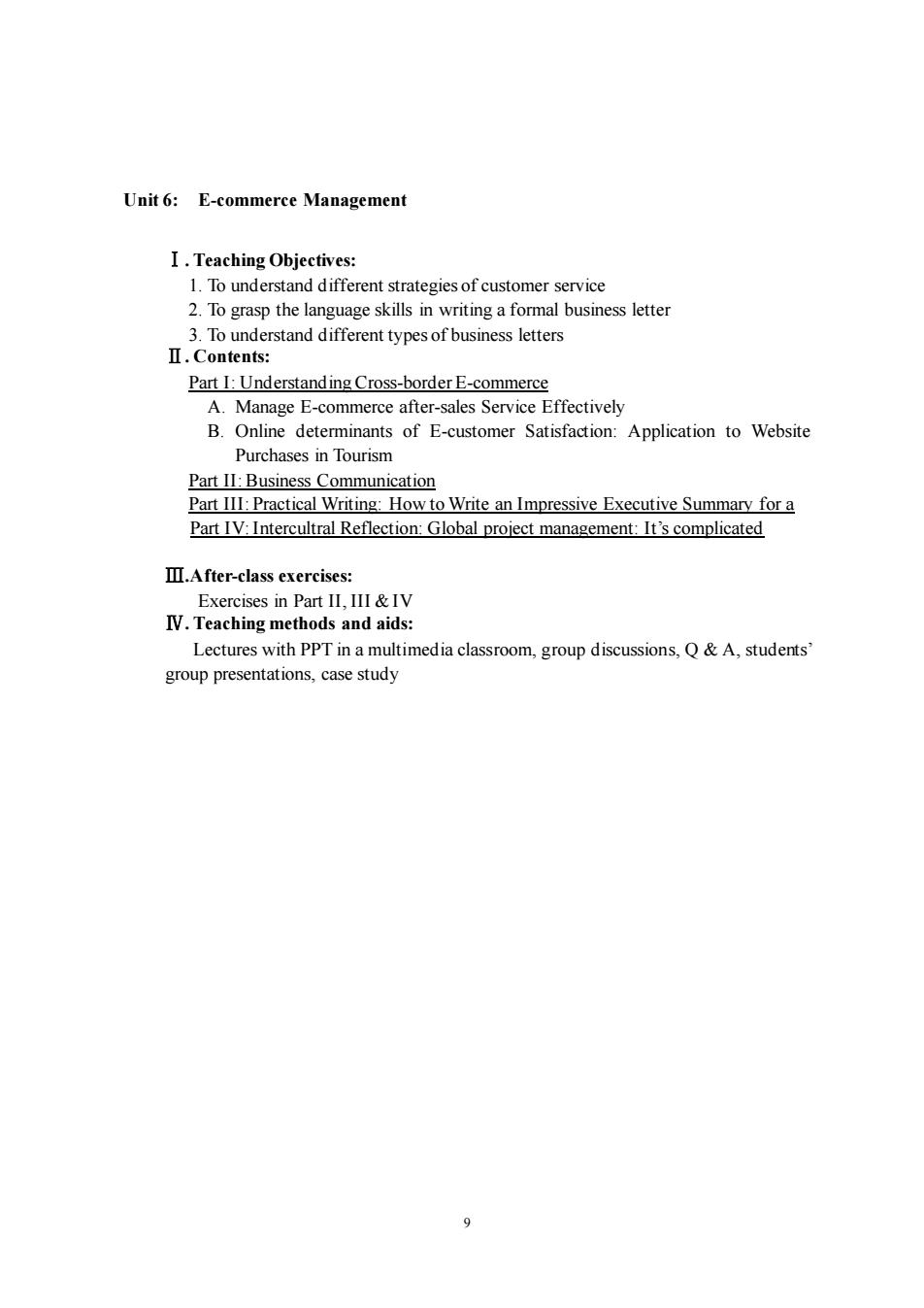
Unit 6:E-commerce Management I.Teaching Obiectives To understand different strategies of customer service 2.To grasp the language skills in writing a formal business letter 3.To understand different types of business letters Ⅱ.Contents: A.Mar age E. commerce after r-sales Service Effectively B.Online determinants of E-customer Satisfaction:Application to Website Purchases in Tourism Part II:Business Communication Part Practical Writing:How to Write an Impressive Executive Summary for a Part IV:Intercultral Reflection:Global project management:It's complicated III.After-class exercises: Exercises in Part II,III &IV IV.Teaching methods and aids: Lectures with PPTina multimedia classroom,group discussions,QA,students group presentations,case study
9 Unit 6: E-commerce Management Ⅰ. Teaching Objectives: 1. To understand different strategies of customer service 2. To grasp the language skills in writing a formal business letter 3. To understand different types of business letters Ⅱ. Contents: Part I: Understanding Cross-border E-commerce A. Manage E-commerce after-sales Service Effectively B. Online determinants of E-customer Satisfaction: Application to Website Purchases in Tourism Part II:Business Communication Part III: Practical Writing: How to Write an Impressive Executive Summary for a Part IV:Intercultral Reflection: Global project management: It’s complicated Ⅲ.After-class exercises: Exercises in Part II, III & IV Ⅳ. Teaching methods and aids: Lectures with PPT in a multimedia classroom, group discussions, Q & A, students’ group presentations, case study
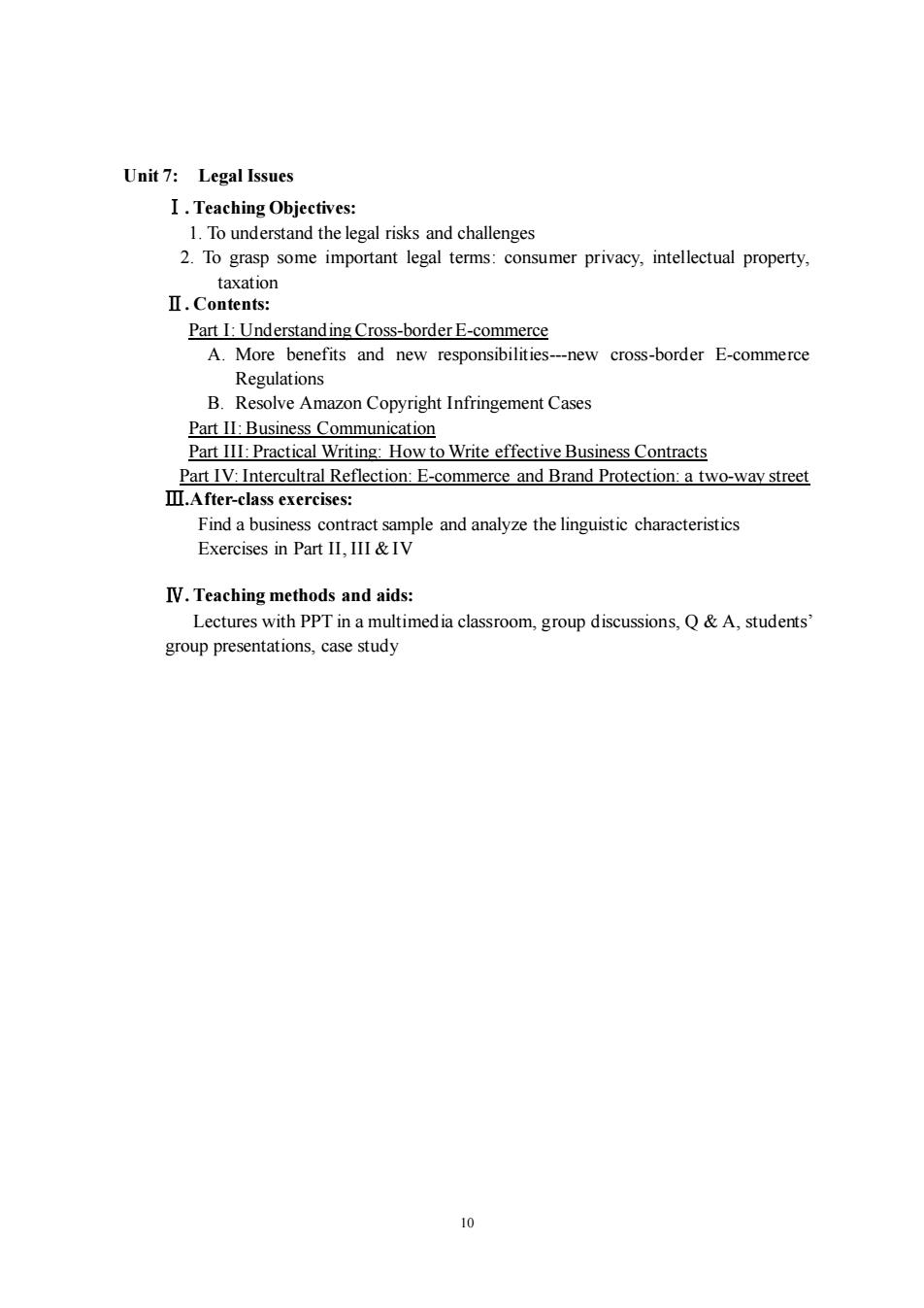
Unit 7:Legal Issues I.Teaching Objectives: 1.To understand the legal risks and challenges 2.To grasp some important legal terms:consumer privacy,intellectual property Ⅱ.Conte Part I:Understanding Cross-border E-commerce A.More benefits and new responsibilities---new cross-border E-commerce Regulations B.Resolve Amazon Copyright Infringement Cases Part II:Busine ommunication Part III:Practical Writing:How to Write effective Business Contracts Part IV:Intercultral Reflection:E-commerce and Brand Protection:a two-way street III.After-class exercises: Find a business contract sample and analyze the linguistic characteristics Exercises in Part II,&IV IV.Teaching methods and aids Lectures with PPT in a multimedia classroom,group discussions,Q&A,students' group presentations,case study 10
10 Unit 7: Legal Issues Ⅰ. Teaching Objectives: 1. To understand the legal risks and challenges 2. To grasp some important legal terms: consumer privacy, intellectual property, taxation Ⅱ. Contents: Part I: Understanding Cross-border E-commerce A. More benefits and new responsibilities---new cross-border E-commerce Regulations B. Resolve Amazon Copyright Infringement Cases Part II:Business Communication Part III: Practical Writing: How to Write effective Business Contracts Part IV:Intercultral Reflection: E-commerce and Brand Protection: a two-way street Ⅲ.After-class exercises: Find a business contract sample and analyze the linguistic characteristics Exercises in Part II, III & IV Ⅳ. Teaching methods and aids: Lectures with PPT in a multimedia classroom, group discussions, Q & A, students’ group presentations, case study